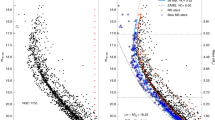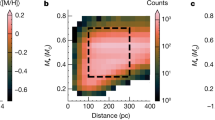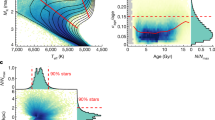Abstract
Star clusters have long been considered to comprise a simple stellar population, but this paradigm is being challenged, since in addition to multiple populations in Galactic globular clusters1, a number of younger star clusters exhibit a significant colour spread at the main sequence turn-off2,3,4,5,6,7,8,9. A sequential evolution of multiple generations of stars formed over 100–200 Myr is a natural explanation of this colour spread10. Another approach to explain this feature is to introduce the effect of stellar rotation11. However, its effectiveness has not yet been proven due to the lack of direct measurements of rotational velocities. Here, we report the distribution of projected rotational velocities (Veqsin i) of stars in the Galactic open cluster M11, measured by Fourier transform analysis. Cluster members display a broad Veqsin i distribution, and fast rotators, including Be stars, have redder colours than slow rotators. Monte Carlo simulations infer that cluster members have highly aligned spin axes and a broad distribution of equatorial velocities biased towards high velocities. Our synthetic cluster simulation further demonstrates how stellar rotation affects the colours of cluster members, suggesting that the colour spread observed in populous clusters can be understood in the context of stellar evolution without introducing multiple stellar populations.
This is a preview of subscription content, access via your institution
Access options
Access Nature and 54 other Nature Portfolio journals
Get Nature+, our best-value online-access subscription
$29.99 / 30 days
cancel any time
Subscribe to this journal
Receive 12 digital issues and online access to articles
$119.00 per year
only $9.92 per issue
Buy this article
- Purchase on Springer Link
- Instant access to full article PDF
Prices may be subject to local taxes which are calculated during checkout




Similar content being viewed by others
Data availability
In this paper, we use publicly available data: photometry from ref. 16, evolutionary tracks from the Geneva Stellar Evolution group (ref. 25; https://www.unige.ch/sciences/astro/evolution/en/?lang=en), astrometry from Gaia Data Release 2 (https://www.cosmos.esa.int/gaia) and spectra from the Gaia–ESO Survey (https://www.gaia-eso.eu/data-products/public-data-releases). New MMT Hα spectra (shown in Supplementary Fig. 1) are available for download at http://hdl.handle.net/2268/228255. The data that support the plots within this paper and other findings of this study are available from the corresponding author upon reasonable request.
References
Bastian, N. & Lardo, C. Multiple stellar populations in globular clusters. Annu. Rev. Astron. Astrophys. 56, 83–136 (2018).
Mackey, A. D. & Nielsen, P. B. A double main-sequence turn-off in the rich star cluster NGC 1846 in the Large Magellanic Cloud. Mon. Not. R. Astron. Soc. 379, 151–158 (2007).
Goudfrooij, P. et al. Population parameters of intermediate-age star clusters in the Large Magellanic Cloud. II. New insights from extended main-sequence turnoff in seven star clusters. Astrophys. J. 737, 3 (2011).
Girardi, L. et al. An extended main-sequence turn-off in the Small Magellanic Cloud star cluster NGC 411. Mon. Not. R. Astron. Soc. 431, 3501–3509 (2013).
Li, C., de Grijs, R. & Deng, L. Not-so-simple stellar populations in the intermediate-age Large Magellanic Cloud star clusters NGC 1831 and NGC 1868. Astrophys. J. 784, 157 (2014).
Li, C., de Grijs, R. & Deng, L. The exclusion of a significant range of ages in a massive star cluster. Nature 516, 367–369 (2014).
Milone, A. P. et al. Multiple stellar populations in Magellanic Cloud clusters—III. The first evidence of an extended main sequence turn-off in a young cluster: NGC 1856. Mon. Not. R. Astron. Soc. 450, 3750–3764 (2015).
Eggen, O. J. The age range of Hyades stars. Astron. J. 116, 284–292 (1998).
Brandt, T. D. & Huang, C. X. The age and age spread of the Praesepe and Hyades clusters: a consistent, ~800 Myr picture from rotating stellar models. Astrophys. J. 807, 24 (2015).
Goudfrooij, P. et al. Population parameters of intermediate-age star clusters in the Large Magellanic Cloud. I. NGC 1846 and its wide main-sequence turnoff. Astron. J. 137, 4988–5002 (2009).
Bastian, N. & de Mink, S. E. The effect of stellar rotation on colour–magnitude diagrams: on the apparent presence of multiple populations in intermediate age stellar clusters. Mon. Not. R. Astron. Soc. 398, L11–L15 (2009).
Turner, J. L. Extreme star formation. Astrophys. Space Sci. Proc. 10, 215–246 (2009).
Conroy, C. & Spergel, D. N. On the formation of multiple stellar populations in globular clusters. Astrophys. J. 726, 36 (2011).
Pancino, E. et al. Chemical abundance analysis of the open clusters Cr 110, NGC 2099 (M 37), NGC 2420, NGC 7789, and M 67 (NGC 2682). Astron. Astrophys. 511, A56 (2010).
Reddy, A. B. S., Giridhar, S. & Lambert, D. L. Comprehensive abundance analysis of red giants in the open clusters NGC 2527, 2682, 2482, 2539, 2335, 2251 and 2266. Mon. Not. R. Astron. Soc. 431, 3338–3348 (2013).
Sung, H. et al. UBVI CCD photometry of M11—II. New photometry and surface density profiles. Mon. Not. R. Astron. Soc. 310, 982–1001 (1999).
Cantat-Gaudin, T. et al. The Gaia–ESO Survey: stellar content and elemental abundances in the massive cluster NGC 6705. Astron. Astrophys. 569, A17 (2014).
Magrini, L. et al. The Gaia–ESO Survey: abundance ratios in the inner-disk open clusters Trumpler 20, NGC 4815, NGC 6705. Astron. Astrophys. 563, A44 (2014).
Tautvaišienė, G. et al. The Gaia–ESO survey: CNO abundances in the open clusters Trumpler 20, NGC 4815, and NGC 6705. Astron. Astrophys. 573, A55 (2015).
Gilmore, G. et al. The Gaia–ESO public spectroscopic survey. The Messenger 147, 25–31 (2012).
Randich, S. et al. The Gaia–ESO large public spectroscopic survey. The Messenger 514, 47–49 (2013).
Gray, D. F. in The Observation and Analysis of Stellar Photospheres 3rd edn 458–504 (Cambridge Univ. Press, New York, 2005).
Milone, A. P. et al. Multiple stellar populations in Magellanic Cloud clusters—VI. A survey of multiple sequences and Be stars in young clusters. Mon. Not. R. Astron. Soc. 477, 2640–2663 (2018).
Dupree, A. K. et al. NGC 1866: first spectroscopic detection of fast-rotating stars in a young LMC cluster. Astrophys. J. Lett. 846, L1 (2017).
Georgy, C. et al. Populations of rotating stars I. Models from 1.7 to 15 M ⊙ at z = 0.014, 0.006, and 0.002 with Ω/Ωcri between 0 and 1. Astron. Astrophys. 553, A24 (2013).
Corsaro, E. et al. Spin alignment of stars in old open clusters. Nat. Astron. 1, 0064 (2017).
Guetter, H. H. & Vrba, F. J. Reddening and polarimetric studies toward IC 1805. Astron. J. 98, 611–746 (1989).
Kamann, S. et al. Cluster kinematics and stellar rotation in NGC 419 with MUSE and adaptive optics. Mon. Not. R. Astron. Soc. 480, 1689–1695 (2018).
Bastian, N. et al. Extended main sequence turnoffs in open clusters as seen by Gaia: I. NGC 2818 and the role of stellar rotation. Mon. Not. R. Astron. Soc. 480, 3739–3746 (2018).
Marino, A. F. et al. Discovery of extended main sequence turn offs in Galactic open clusters. Astrophys. J. Lett. 863, L33 (2018).
McNamara, B. J., Pratt, N. M. & Sanders, W. L. Membership in the open cluster M11. Astron. Astrophys. Sup. 27, 117–143 (1977).
Su, C.-G., Zhao, J.-L. & Tian, K.-P. Membership determination of stars using proper motions in the region of the open cluster M 11. Astron. Astrophys. Sup. 128, 255–264 (1998).
Gaia Collaboration et al. The Gaia mission. Astron. Astrophys. 595, A1 (2016).
Gaia Collaboration et al. Gaia Data Release 2. Summary of the contents and survey properties. Astron. Astrophys. 616, A1 (2018).
Szentgyorgyi, A. et al. Hectochelle: a multiobject optical echelle spectrograph for the MMT. Publ. Astron. Soc. Pac. 123, 1188–1209 (2011).
Lim, B. et al. A constraint on the formation timescale of the young open cluster NGC 2264: lithium abundance of pre-main sequence stars. Astrophys. J. 831, 116 (2016).
Lim, B. et al. Kinematic evidence for feedback-driven star formation in NGC 1893. Mon. Not. R. Astron. Soc. 477, 1993–2003 (2018).
Pasquini, L. et al. Installation and commissioning of FLAMES, the VLT multifibre facility. The Messenger 110, 1–9 (2002).
Dekker, H. et al. Design, construction, and performance of UVES, the echelle spectrograph for the UT2 Kueyen Telescope at the ESO Paranal Observatory. In Proc. SPIE 4008: Optical and IR Telescope Instrumentation and Detectors 534–545 (2000).
Brown, A. G. A. & Verschueren, W. High S/N echelle spectroscopy in young stellar groups II. Rotational velocities of early-type stars in SCO OB2. Astron. Astrophys. 319, 811–838 (1997).
Royer, F., Zorec, J. & Gómez, A. E. Rotational velocities of A-type stars III. Velocity distributions. Astron. Astrophys. 463, 671–682 (2007).
Royer, F., Gerbaldi, M., Faraggiana, R. & Gómez, A. E. Rotational velocities of A-type stars I. Measurement of v sin i in the Southern Hemisphere. Astron. Astrophys. 381, 105–121 (2002).
Al-Naimiy, H. M. Linearized limb-darkening coefficients for use in analysis of eclipsing binary light curves. Astrophys. Space Sci. 53, 181–192 (1978).
Castelli, F. & Kurucz, R. L. New grids of ATLAS9 model atmospheres. Preprint at https://arxiv.org/abs/astro-ph/0405087 (2004).
Gray, D. Precise rotation rates for five slowly rotating A stars. Astron. J. 147, 81 (2014).
Kovacs, G. Signature of non-isotropic distribution of stellar rotation inclination angles in the Praesepe cluster. Astron. Astrophys. 612, L2 (2018).
Georgy, C. et al. Populations of rotating stars III. SYCLIST, the new Geneva population synthesis code. Astron. Astrophys. 566, A21 (2014).
Worthey, G. & Lee, H.-C. An empirical UBV RI JHK color–temperature calibration for stars. Astrophys. J. Suppl. Ser. 193, 1 (2011).
Mermilliod, J.-C. Comparative studies of young open clusters. III—empirical isochronous curves and the zero age main sequence. Astron. Astrophys. 97, 235–244 (1981).
Acknowledgements
The authors thank M. Bessell, S. Ekström and D. Gray for helpful comments, as well as P. Berlind, M. Calkins, C. Ly, S. Kattner and N. Caldwell for assisting with the Hectochelle observations. B.L. is grateful for assistance from S. Kim in running the simulation codes. This research was supported by the Basic Science Research Program through the National Research Foundation (NRF) of Korea (grant number NRF-2017R1A6A3A03006413), and the BK21 plus programme through the NRF funded by the Ministry of Education of Korea. This uses data obtained under the K-GMT Science Program (PID: MMT-2017A-1) funded through the K-GMT Project operated by the Korea Astronomy and Space Science Institute (KASI), and from the European Space Agency mission Gaia (https://www.cosmos.esa.int/gaia), processed by the Gaia Data Processing and Analysis Consortium (https://www.cosmos.esa.int/web/gaia/dpac/consortium). Funding for the Gaia Data Processing and Analysis Consortium has been provided by national institutions, in particular the institutions participating in the Gaia Multilateral Agreement. Y.N. (an FNRS research associate) and G.R. acknowledge support from the FNRS and the PRODEX contract, Belgium. H.S. acknowledges support from the NRF of Korea (grant number NRF-2015R1D1A1A01058444). N.H. acknowledges support from the Large Optical Telescope Project operated by KASI. B.-G.P. acknowledges support from the K-GMT Project operated by KASI.
Author information
Authors and Affiliations
Contributions
B.L. proposed the project, analysed the data and wrote the manuscript. G.R. computed the gravity-darkening effects. Y.N. developed the Fourier transform code. H.S. was involved with project planning. All co-authors participated in discussions and contributed to improving the manuscript.
Corresponding author
Ethics declarations
Competing interests
The authors declare no competing interests.
Additional information
Publisher’s note: Springer Nature remains neutral with regard to jurisdictional claims in published maps and institutional affiliations.
Supplementary information
Supplementary Information
Supplementary text, Supplementary references, Supplementary Figures 1–12, Supplementary Tables 1–4
Supplementary Data 1
Machine-readable version of Supplementary Table 1
Supplementary Data 2
Machine-readable version of Supplementary Table 4
Rights and permissions
About this article
Cite this article
Lim, B., Rauw, G., Nazé, Y. et al. Extended main sequence turn-off originating from a broad range of stellar rotational velocities. Nat Astron 3, 76–81 (2019). https://doi.org/10.1038/s41550-018-0619-5
Received:
Accepted:
Published:
Issue Date:
DOI: https://doi.org/10.1038/s41550-018-0619-5
This article is cited by
-
Science with a Small Two-Band UV-Photometry Mission II: Observations of Stars and Stellar Systems
Space Science Reviews (2024)
-
What is a globular cluster? An observational perspective
The Astronomy and Astrophysics Review (2019)



